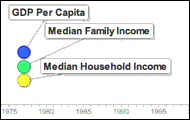 What does the gross domestic product tell us about our quality of life and economic well-being? If you ask Nobel laureate and economist Joseph Stiglitz, he'll say -- Not much. And then he'll tell you to look at median household income instead.
What does the gross domestic product tell us about our quality of life and economic well-being? If you ask Nobel laureate and economist Joseph Stiglitz, he'll say -- Not much. And then he'll tell you to look at median household income instead.
In his May 16 New York Times Magazine article about GDP, writer Jon Gertner featured Stiglitz for good reason. Stiglitz recently served as the head of a commission formed by French President Nicolas Sarkozy to identify the limits of GDP. And he and his international team of economists and statisticians produced an expansive report outlining a dashboard of indicators for measuring progress -- considered as alternatives to GDP.
His oft-repeated mantra is "What we measure affects what we do." In his view, using the wrong metrics will inevitably lead to the wrong policies.
Public Perception and Economic Reality
In addition to wasting time and taxpayer money on bad policy, the gap between expectations and economic growth can erode the public's trust in the government, according to Stiglitz. "One of the reasons that most people may perceive themselves as being worse-off even though average GDP is increasing is because they are indeed worse-off," Stiglitz said in official reflections on the commission's report.
In the Times article, which also profiled State of the USA, he cited an example of the president pointing to robust GDP growth as a sign of American's prosperity. According to the article, measures like GDP per capita (a mean, or average, measure) can be distorted by profits of top earners and while data show that some Americans are prospering, many are not.
Focusing on Different Measures Over Time
Looking at median measures (the middle value in a set with an equal number above and below), Stiglitz noted how median household income had declined over the past decade while GDP per capita had gone up. "When you have increasing inequality, median and average behave differently," Stiglitz said in the Times article.
Taking the long view, how have median household income and median family income, both median measures of income, grown relative to GDP per capita over a span of four decades? This interactive motion chart shows the percent change in each of these figures from 1967. The data table below shows the inflation-adjusted values for each year, but the GDP figures are in chained 2005 dollars so the comparison is not exact. ("Chained" dollars is a method of adjusting real dollar amounts for inflation over time.)
With different indicators, could the recession have been prevented? Could more effective policies have been enacted in time to forestall the financial crisis? Use the interactive chart and the data table to draw your own conclusions.
Notes:
- GDP Per Capita is in Chained 2005 dollars.
- Median Household Income is in 2008 CPI-U-RS adjusted dollars.
- Median Family Income is in 2008 CPI-U-RS adjusted dollars.
Data Sources:
- Table H-5. Race and Hispanic Origin of Householder--Households by Median and Mean Income:1967 to 2008
- Table F-7. Type of Family, All Races by Median and Mean Income: 1947 to 2008
- Table 7.1. Selected Per Capita Product and Income Series in Current and Chained Dollars
Definitions:
- Household Income: The sum of the income of the head of the household and all other individuals aged 15 and up in the household, whether they are related to the head of the household or not.
- Family Income: The sum of the incomes of all individuals aged 15 and up in the household, who are related to the head of the household.
- GDP Per Capita: The GDP divided by the total population of the United States.
- Mean: The average of a set of numbers. The sum of items in a set divided by the number of items in that set.
- Median: The middle value in a distribution of numbers. An equal number of values lie above and below the median.
NY Times Magazine Article: The Rise and Fall of GDP by Jon Gertner
The Commission's Findings: The Stiglitz Report (PDF)
Reflections and Overview of the Report: The Measurement of Economic Performance and Social Progress Revisited (PDF)
Video: Measuring Progress, Comments by Stiglitz
Learn More About the Commission: Stiglitz Commission Homepage
Related: NY Times Highlights State of the USA's Work, Mission and Times Article Sparks Reader Questions, Imagination
Data visualization by Anthony Calabrese, a State of the USA Web producer.
 Print This
Print This RSS Feed
RSS Feed